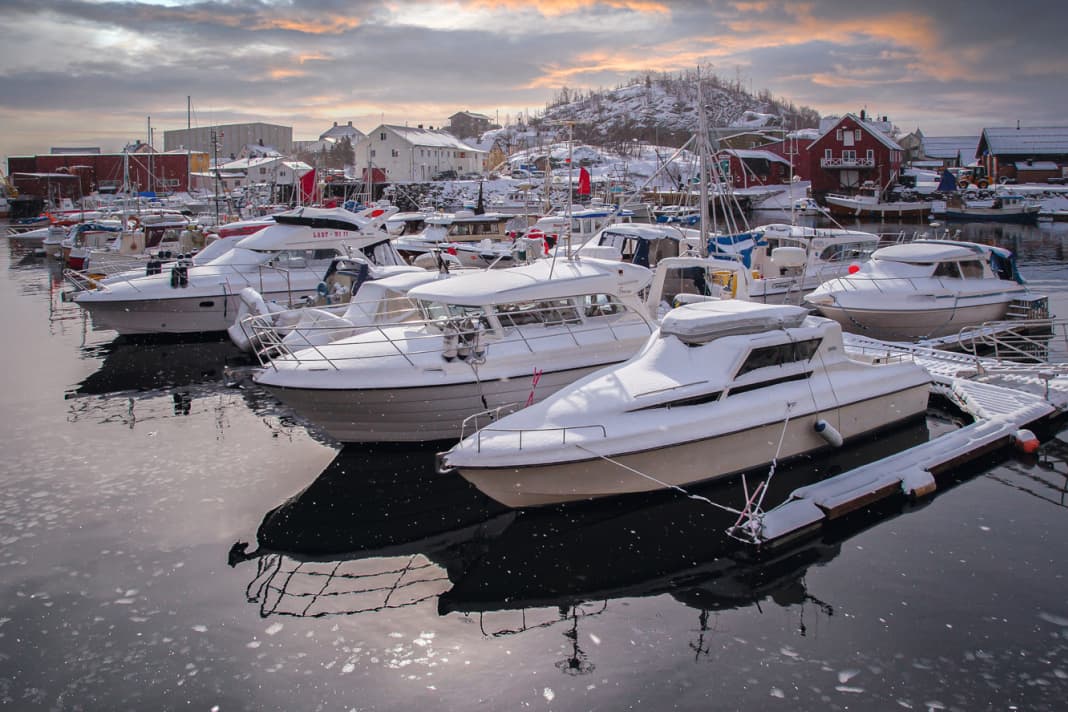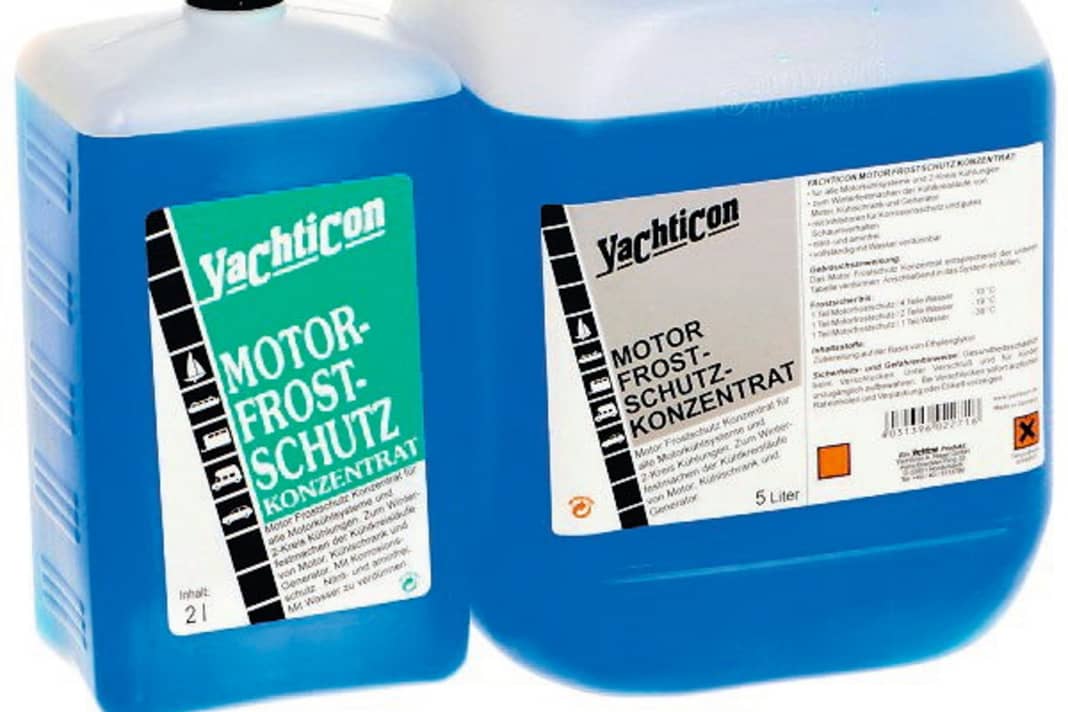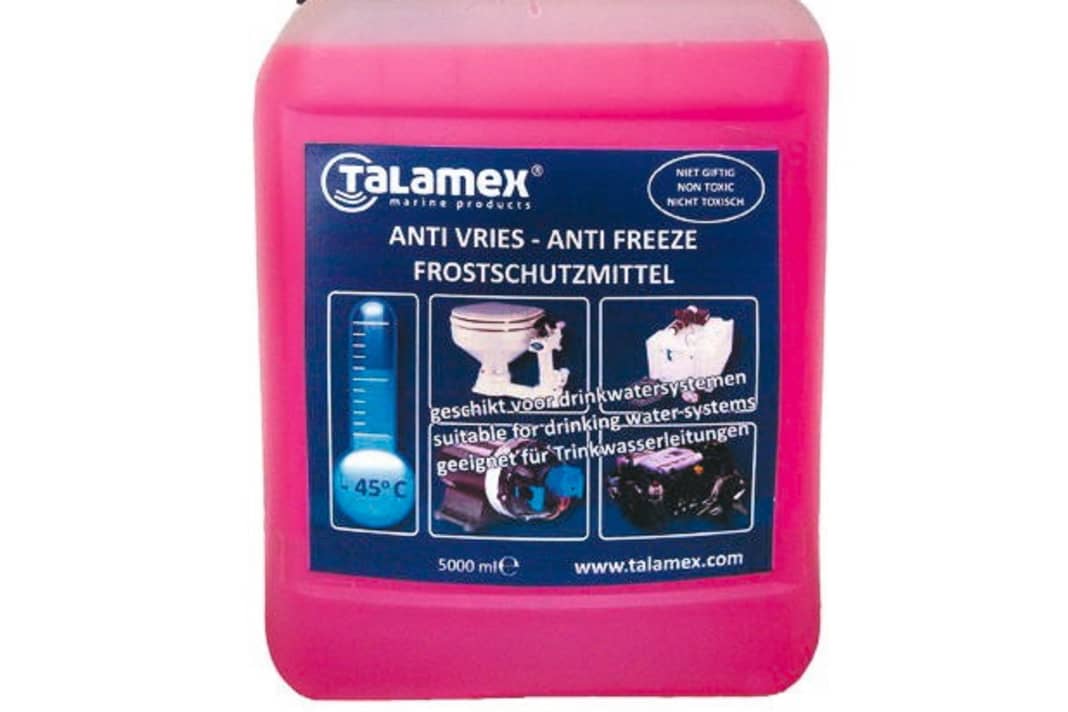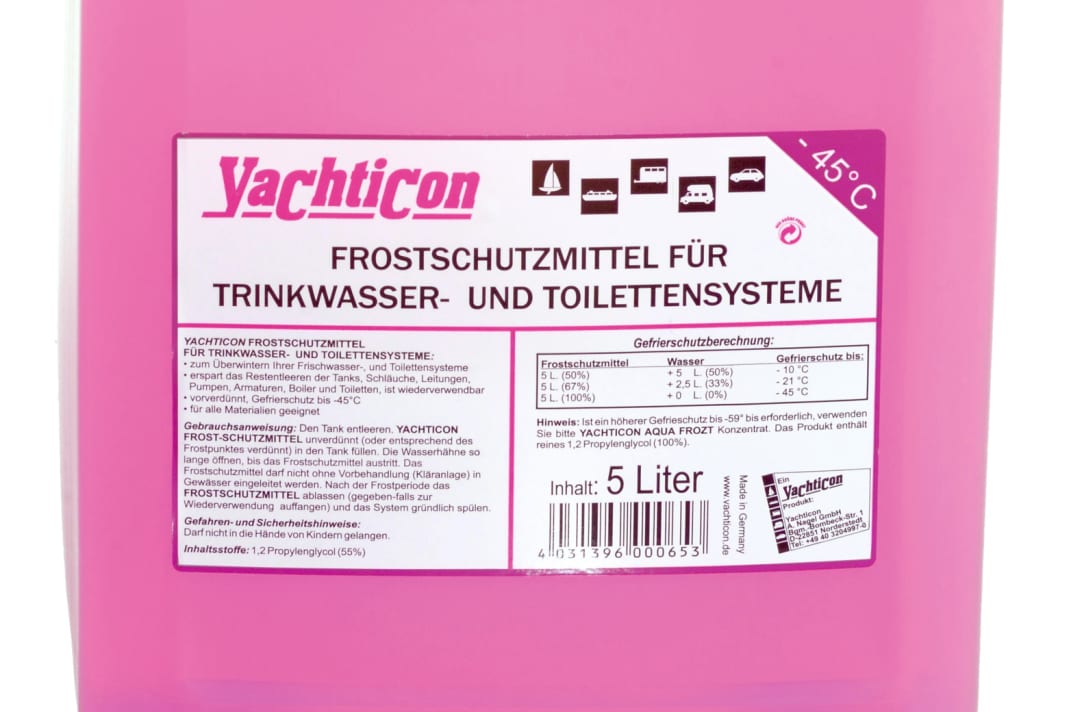





Further parts of the winter series:
"Somehow we must have been sloppy when clearing out the ship in autumn," is the comment from the galley. A bottle of mineral water had been left behind in the locker - and now, at 15 degrees below zero in winter, it had burst. An impressive example of how important it is to winterise the boat properly and make it "frost-proof".
When water freezes, it expands. A truism. More precisely, water increases in volume by up to ten per cent when it freezes. If it is in a closed space such as a container or tank, it develops considerable pressure on the outer walls. At low temperatures, water therefore needs space to expand. If not to the side, then at least diagonally upwards. This is also the reason why gutters in northern Europe are semi-circular. If they were rectangular, as in the Mediterranean region, plumbers in this country would have a lot more to do. However, it is not always possible to remedy the situation with structural measures. This is why, alongside corrosion and wear, frost is the third major enemy of marine engines.
Winterising advice
"You have to put antifreeze in all the pipes so that they don't burst," the novice is told as good advice when winterising the boat for the first time, "The alcohol in it is what keeps it frost-free." After all, the pungent, sweet smell of alcohol also stings your nose when you turn on the windscreen wipers in your car.
But could I also use windscreen washer fluid to winterise my drinking water tank, for example? Many boat owners stand in the DIY store every autumn and ask themselves about the differences between the brightly coloured liquids. Doesn't it matter what I use for frost protection as long as it contains enough alcohol?
Not at all. This is because antifreeze is not only intended to protect against frost, and the different agents have distinct differences in their properties. If used incorrectly, the ship can suffer serious damage and, in the worst case, even sink.
Glycol instead of alcohol
The reason why a mixture of ethanol (colloquially: alcohol) and water only freezes at very low temperatures lies in the difference between the molecules of ethanol and water. They are so different that it is almost impossible for the water to form a common ice crystal lattice because it is permanently disturbed by the ethanol molecules mixed in it. This is why the mixture remains liquid even in winter. At least up to very extreme temperatures. With most antifreezes down to minus 50 degrees. The ethanol therefore lowers the freezing point of water.
With its specific freezing point of minus 114 degrees Celsius, ethanol is generally very suitable for protecting against frost. This is why it is also used in defrosting products such as door de-icer. But antifreeze also has other functions. When used in the engine, it is primarily a coolant. However, ethanol with a boiling temperature of 78 degrees is not at all suitable for this application, as the coolant would begin to boil even earlier than water. Boat and car engines usually operate at 90 degrees.
This is the reason why the bivalent alcohol ethylene glycol or colloquially "glycol" is used in coolants instead of monohydric alcohol. Although the melting point of pure glycol is only minus 15 degrees, in combination with water the solidification temperature is even lower. A glycol-water mixture in a 1:1 ratio only freezes at minus 40 degrees.
Although glycol is derived from ethanol, it is a completely different liquid. The viscosity, for example, is much higher and the fluid feels almost oily. This is an advantage because it lubricates moving parts such as the cooling water pump and thermostat at the same time.
Heat capacity
In contrast to a car engine, where the waste heat is channelled into the very large radiator grille via the cooling circuit and then dissipated by the airstream or the fan when stationary, it is all the more important that the heat capacity of the coolant is high enough for a marine engine. This is because, compared to car engines, marine engines are usually located deep in the boat's cellar. Fresh oxygen can often only get there through a fan, but heat often cannot get away. The marine engine only gets rid of its heat through the heat exchanger, which seems tiny compared to a car radiator.
Use in the engine
The dual-circuit cooling system commonly used in boat engines today consists of an inner and an outer circuit. Both are connected by the heat exchanger, in which (as the name suggests) the heat from the inner circuit is transferred to the outer circuit. The inner circuit is filled with anti-freeze, which is pumped through the cooling channels in the engine block by a circulation pump, where it absorbs the heat and transfers it to the outer circuit in the heat exchanger. The external circuit is fed with fresh seawater, which is drawn in by the cooling water pump and injected through the heat exchanger into the exhaust system to cool it. The exhaust gases are then mixed with the sea cooling water in the water collector and channelled out via the exhaust in gushes.
In addition to glycol, the engine antifreeze also contains certain additives that have different functions. The agents and active ingredients differ depending on the specification of the antifreeze. However, the tasks of the additives are the same in every
Antifreeze is the same: corrosion protection for the engine, water pump and cooling ducts, as the water admixture has a naturally corrosive effect on the metal. Prevention of mineral deposits (e.g. limescale) and protection against cavitation.
Cavitation
Many people only know cavitation from the propeller. The term describes the formation of vapour bubbles in a moving liquid. They always form when the static pressure of a liquid suddenly drops below its specific vapour pressure. In contrast to water, which has a vapour pressure of around 0.7 bar at operating temperature, the antifreeze mixture reduces the value to 0.5 bar. The probability of cavitation is therefore reduced by the antifreeze. The cooling water circuit of a running engine is kept at a pressure of around 1 to 1.5 bar by the cooling water pump. While the vapour pressure of a mixture of water and antifreeze is still around 0.1 bar when the engine is started in cold cooling water, the vapour pressure at operating temperature (90 degrees) is already 0.5 bar. - This is still a long way from the operating pressure of the engine. However, the cooling water system has some bottlenecks and obstacles. For example, when the liquid molecules slow down shortly before entering the channel to the water pump in order to line up with the impellers, vapour bubbles can form there. Bubbles can also form when the engine warms up and cools down, as the vapour pressure of a liquid depends on the temperature of this liquid.
If these bubbles then reach the area of higher pressure with the flow, they implode suddenly, which can lead to damage in the cooling water system and in the engine. In older cooling water pumps, regular indentations can often be seen in the metal at the outlet of the cooling water channel, caused by imploding vapour bubbles.
Technologies
In the past, all anti-freeze agents contained silicates. They have the advantage that they protect the material by building up a protective layer of aluminium silicate on the aluminium parts. The disadvantage is that this protection only lasts for a few years and the antifreeze has to be replaced frequently. In order to extend the period of use, it was decided to use organic compounds instead of silicate for corrosion protection. However, there were now two different types on the market, the colours of the liquids were not standardised and mix-ups were a constant source of problems.
This is because mixing the two systems can lead to clumping, causing the channels to clog. Aggressive acids are also produced during the mixing process. This is why the hybrid system was developed, which combines the advantages of both systems (compatibility with aluminium and longer service life) and can also be mixed with the previous systems. It also has better heat dissipation, better corrosion protection and a significantly higher boiling point of 135 degrees. However, hybrid systems are not the be-all and end-all and are equally suitable for all machines. The choice for your own engine should always be made according to the manufacturer's specification. The colour alone says nothing. Furthermore, only coolants of the same colour should ever be used, as otherwise the additives they contain may interfere with each other.
Ready-mix or antifreeze concentrate?
There are many antifreeze concentrates and ready-mixes on the market. Anyone who thinks "a lot helps a lot" and pours the undiluted concentrate into the engine to be on the safe side is making a mistake. Because even if the freezing temperature is lowered and the boiling point raised by using excessive amounts of glycol, the disadvantage of pure glycol is that it has a much lower heat capacity (2.4 kJ/(kg-K)). In a 50:50 mixture with water, the heat capacity increases to 3.5 kJ/(kg-K). Therefore, when using pure glycol, a larger volume flow is required to transport the same amount of heat. The hoses would have to have a much larger cross-section. Another disadvantage of glycol: when using air-permeable plastic pipes, oxygen can reach the liquid and oxidise the glycol to form carboxylic acids, which can attack the metallic components of the system.
The safest option therefore remains a ready-mix. When mixing yourself, at least 30 per cent glycol should be used to ensure adequate protection. However, never use more than 60 per cent, otherwise there is a risk of overheating.
Changing the coolant
Coolant does not last indefinitely. It loses its properties and needs to be changed from time to time, especially when subjected to long and high thermal loads. Over the years of use, heavy metal particles, traces of engine oil and other impurities also dissolve in it.
After draining the coolant and especially if you do not know which fluid was last used, it is a good idea to flush the engine with water several times. Then top up with the correct coolant. Fill the expansion tank to the maximum level. Let the engine run. When cold, top up to a level midway between minimum and maximum.
Waste disposal
Glycol can be disposed of at most landfill sites or toxic waste collection centres. It can also be disposed of at some garages that have their own collection containers. There are also a large number of service providers who will accept used glycol for a small fee or even free of charge, and will even collect larger quantities. Some larger marinas and shipyards even have collection containers where berth holders can dispose of their glycol.
Winterising the machine
When winterising the machine, it is important that all remaining seawater is either drained or replaced with antifreeze. For single-circuit cooled machines, this is best done in the water, as they must first be warmed up before winterising so that the thermostat opens. Otherwise, only the cooling water path from the seacock to the water pump and then the exhaust system would be flushed with antifreeze. If the ship is already on land, it is necessary to run the engine with fresh water first in order to warm it up. This can be done by pulling the intake hose from the seacock and connecting it to a water barrel. (Or into a bucket and then refilling with a hose.) Alternatively, the lid of the sea water filter can be unscrewed and the fresh water filled in. To ensure that the fresh water is sucked into the engine and does not go out through the open sea cock, it is important that the sea valve is closed. When the engine is warm, the antifreeze is then filled in instead of fresh water until the cooling water comes out of the exhaust pipe coloured.
For dual-circuit cooled machines, the seawater-cooled circuit is flushed and filled with antifreeze as described. The inner cooling circuit between the engine block, circulation pump and heat exchanger is already filled with antifreeze. However, a refractometer should be used to test whether the antifreeze is sufficient when the engine is cold. Ideally, the measured value should be between minus 20 and 30 degrees. The antifreeze should also be replaced every three years because it loses its corrosion-inhibiting properties over time.
With Z-drives, the antifreeze mixture can be fed directly from a water bucket to the cooling water intake opening of the Z-drive using an electric pump and flushing jaws. A second bucket should also be positioned under the drive to collect the returned cooling water.
Antifreeze for engines



Winterising on-board WC
Winterising the on-board toilet and faeces tank is similar to winterising the engine. The tank should be completely pumped out before uncraning. The antifreeze is then poured into the toilet and pumped out from there for a while to make the chopper pump frost-proof. It is even safer to disconnect the hose from the ball valve and draw in the antifreeze directly from there in order to fill the suction tract with antifreeze as well. If the flushing of the on-board toilet is supplied from the fresh water tank, it is also necessary to fill the hose from the tank to the toilet with frost protection.
The faeces tank cannot usually be emptied completely, but the antifreeze pumped into the tank from the toilet will mix with the residual water. However, it is also important to prime the drain pump of the tank on the seaward side with antifreeze.
A common mistake is to winterise the on-board toilet with the simplest and cheapest antifreeze from the DIY store - "it will do for the toilet". However, this is often antifreeze containing silicate, which attacks the rubber and seals. Even if leaks caused by antifreeze are rare, the product will damage the rubber hoses by allowing odours to diffuse through the rubber more quickly. It is advisable to use special antifreeze approved for the sanitary system.
Antifreeze for toilets



Winterising the water tank
The water tank should also be drained in autumn before the system is made frost-proof. In the past, it was common practice to winterise the drinking water pump with one or two bottles of grain. Grain is cheap, frost-free and it is also not harmful if residual amounts end up in the toothbrush cup. All you have to do is disconnect the hose from the tank, hold it in the bottle, pump three times and you're done. Unfortunately, this method of winterising is not really frost-proof, as the alcohol evaporates over the winter. In addition, the alcohol is likely to attack seals and rubber parts. This "cheap solution" is therefore strongly discouraged.
After emptying the fresh water tank and the boiler, it is better to fill it from above with an anti-freeze mixture suitable for the intended use and to draw it in via the pressurised water pumps to all tapping points until coloured water comes out of the tap. Otherwise, in particularly cold winters, trapped water in the wash taps may expand and damage them. The tap should therefore also be left open during the winter. Don't forget the outdoor shower and the shower sump with the float pump, which often has a little water left in it.
Antifreeze for drinking water






